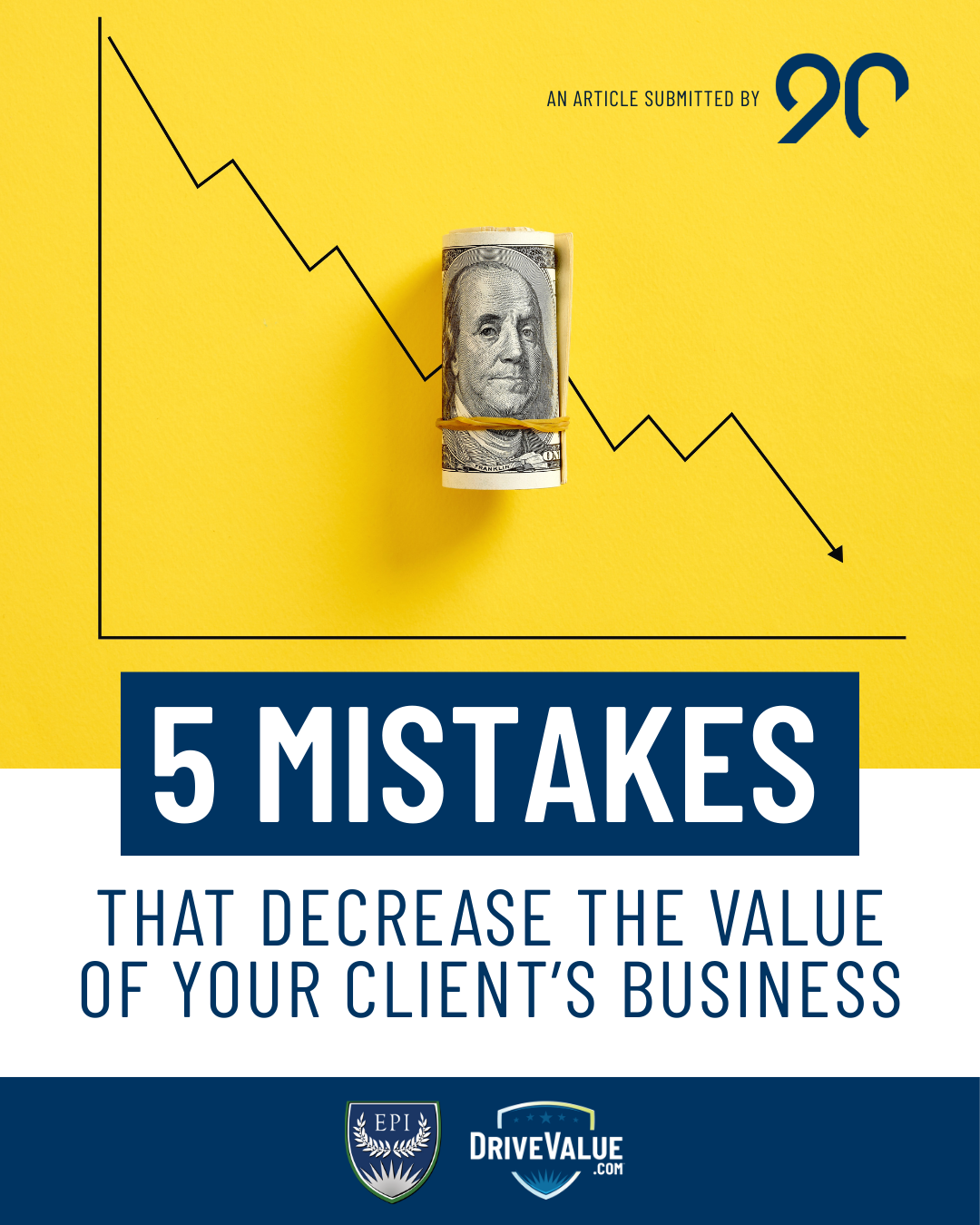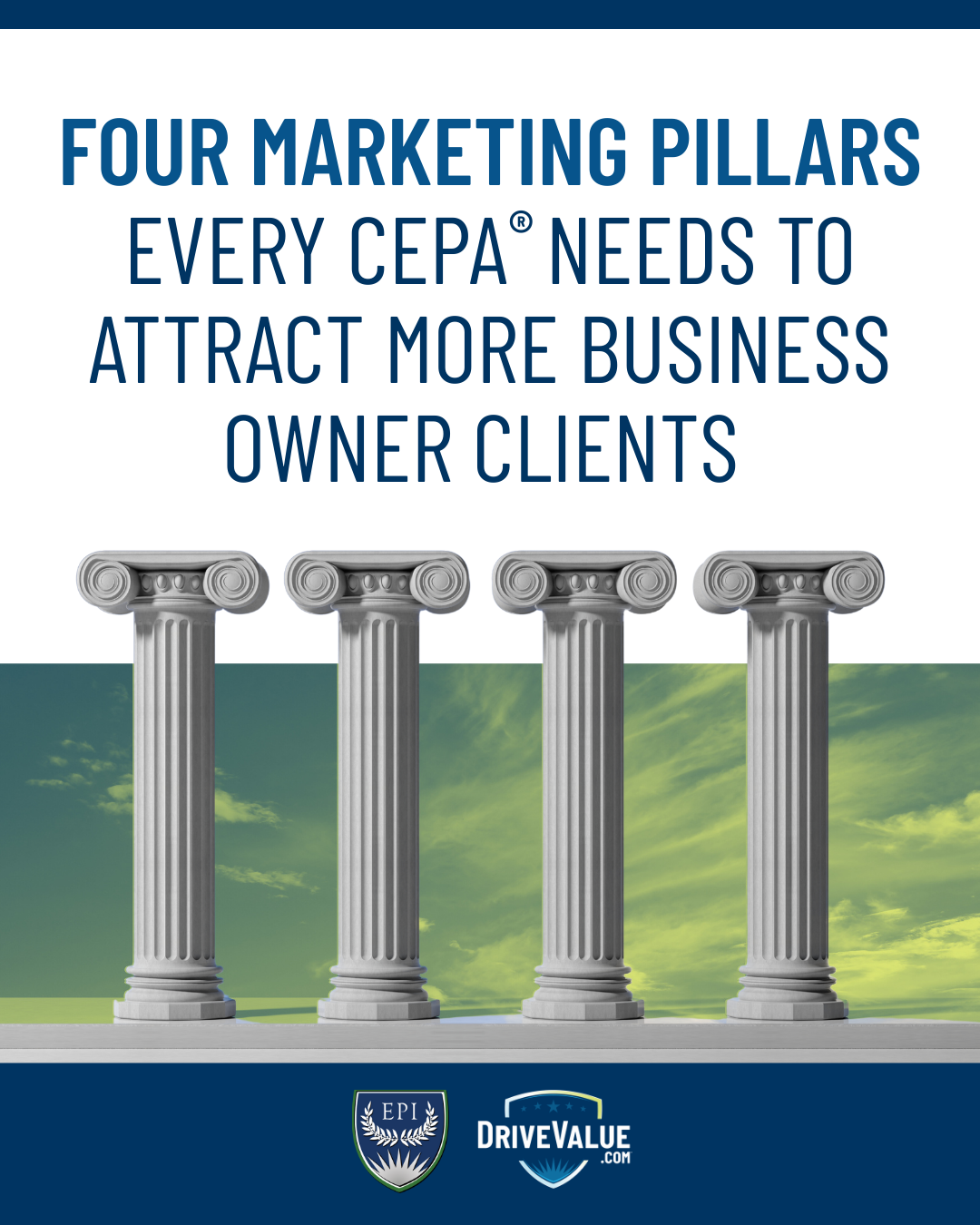
THE EXIT PLANNING BLOG
Keep up-to-date with exit planning, succession planning, industry trends, unique specialty insights, and useful content for professional advisors and business owners.
Share this
5 Mistakes that Decrease the Value of Your Client’s Business
by Kris Snyder on September 3, 2025

When it comes to guiding clients toward a successful exit, most Certified Exit Planning Advisors (CEPA®) excel at the early work: helping owners clarify goals, get a valuation, and start building a plan. That’s the Discover gate. But where clients start to lose momentum is in the Prepare gate when it’s time to actually build a business that can scale, run without the owner, and attract buyers at the valuation they want.
This is where most clients struggle. They don’t need more planning. They need to execute.
That’s why the successful clients implement a complete business operating system like EOS with Ninety. It gives companies the structure, tools, and discipline they need to align their teams, track what matters, and consistently move the business forward. And Ninety provides the platform to bring that operating system to life, helping clients build the execution muscle that drives real enterprise value.
Below are 5 common mistakes that occur during the Prepare gate, and how you can help your clients avoid them.
1. Setting Growth Targets Without Structure
It is important to differentiate Standard Work (the work we do to move the business forward each week) from Goals/Rocks (which we set to fix, advance, or innovate in the business). Your client sets aggressive growth goals. Then hits none of them. Without a clear structure in place, growth goals become wishful thinking. There’s no prioritization, no accountability, and no way to measure if the company is actually moving forward. The team is busy, but growth, if it exists, is driven by hustle, not by scorecards measuring what we do. Structure is what turns goals into results. Without it, setting goals is like hanging ornaments on a tree that hasn’t been planted yet. There’s no root system and no alignment, just short-term hustle that’s hard to sustain.
The solution:
Encourage your clients to create a scalable structure that includes a clear Accountability Chart™ and defined seats. This helps your clients become less founder-dependent and more focused. When every team knows what they own and how success is measured, goal setting becomes strategic, not reactive. Structure turns ideas into execution, and execution into enterprise value.
"We use Ninety for all of our clients. Every trusted advisor is a member of the team. They are able to see our Vision + Goals, complete their Rocks, track their To-Dos, and help us solve issues. Ninety keeps us all focused on achieving the Owners' goals."
- Ryan McGarghan, CEPA®/Fractional CFO
2. Using Data Reactively Instead of Predicting
A revenue dip catches your client off guard, and they are scrambling to fix it. When leaders only look at data after something goes wrong (a missed goal, a dip in revenue, or a surprise resignation) they’re always playing catch-up. By the time they spot the issue, the damage is often done. That is why weekly scorecards need 5-15 proactive leading indicators, not lagging. Reactive data use leads to decision-making based on emotion, not clarity.
The solution:
Help your clients use leading data instead of reactive or lagging. Predictive data gives teams a weekly pulse on the business and their departments, helping them see issues and solve them before it's too late. It also creates a culture of accountability and continuous improvement, where data guides conversations, actions, and priorities. To help your clients use data predictively, create Scorecards that give every team visibility into performance. Then ensure they review these metrics in their regular meetings, tie them to specific goals, and gain agreement of ownership to accountable team members.
3. Running Ineffective Meetings That Waste Time
Your client’s calendar is packed, but nothing gets solved. Meetings that lack purpose, rhythm, or resolution reduce a company's effectiveness and lower morale. When agendas are unclear or nonexistent, meetings take far too long and leave teams more confused than aligned. Worse, they signal a lack of internal alignment that can be a red flag to potential acquirers.
The solution:
To help your clients lead effective meetings, establish a consistent meeting cadence with a shared, repeatable agenda. Set time expectations and make space to solve problems and plan for the future, not just report status. Have your clients use a meeting platform like Ninety to contribute Issues to the agenda and stay on track with a clearly defined flow. A high-functioning company runs meetings that drive accountability, solve problems, and advance priorities. This efficiency shows discipline and increases perceived value.
4. Ignoring Enterprise Value as a Strategic Focus
Ignoring Enterprise Value as a strategic focus is a mistake that too many leaders make — often because it feels abstract or too far in the distance. But the truth is, enterprise value isn’t just a financial metric; it’s a lens that can transform how you build and lead your company. When enterprise value is an afterthought, leaders often stay in the weeds, making themselves the center of operations. This results in bottlenecks, founder dependence, and an organization that can’t scale without constant oversight.
The solution:
Help your clients prioritize understanding and building enterprise value and shift their thinking to the long-term. Ask questions like “Are your systems built to last? Can this company run without you? Are you tracking the right metrics that prove performance and reduce risk? Have you clearly defined our Vision and built alignment around it?” When done right, enterprise value also becomes a powerful alignment tool for your leadership team. It aligns your client’s leadership team around improving key drivers: growth, margin, recurring revenue, customer retention, culture, and operational efficiency. The best part? Enterprise value compounds. Ninety is built to assist you and your clients in the Prepare and Decide gates, such that you can track the progress on all of the key metrics that build your enterprise value.
5. Not Setting Quarterly Goals (Rocks)
Everyone is busy, but no one is working towards the same objectives. Without quarterly goals, teams are left navigating without a clear destination or in silos. Everyone may be working hard, but not necessarily on the right things. Over time, this lack of focus leads to inefficiencies, confusion, and missed opportunities. Without this structure, weekly meetings become less productive, people struggle to define success, and progress becomes harder to measure.
The solution:
Want to help your clients create a more aligned, focused, and high-performing team? Start with quarterly goals. They’re one of the simplest and most powerful tools for turning vision into results. Quarterly goals, or Rocks, as we call them at Ninety, help turn your client’s long-term Vision into short-term action. They force clarity around what matters most right now and create a shared understanding of priorities across the organization. Help your client review their Vision and then set visible, measurable, and trackable goals to help the business get to the next stage. Then, help them set and communicate meaningful 90-day goals for both individuals and teams that ladder up to these large-scale goals. When everyone sees how their daily work connects to something larger, productivity skyrockets.
Help Your Clients Scale with Ninety
Valuable businesses aren’t built by accident but by leaders who focus on the right things at the right time. Provide value to your clients by creating resilience, clarity, and scalability, attracting buyers, investors, and top talent. Ninety supports your clients in setting their vision, creating their initial organizational chart, and establishing meetings and priorities that help guide their business. Learn more about how Ninety can help your clients build the execution muscle they need.
Related Resources
- Breaking Through the Growth Plateau: A Guide for Founders Ready to Scale and Exit
- How CEPAs Can Build Stronger Client Relationships and Unlock New Opportunities
- About the EPI Partner Network
Share this
- Blog (545)
- CEPA (422)
- exit planning (249)
- CEPA community (187)
- Business Owner (172)
- Exit Planning Summit (96)
- EPI Chapter Network (89)
- Value Acceleration Methodology (80)
- Exit Planning Partner Network (76)
- EPI Announcement (49)
- Content (48)
- Webinars (37)
- Excellence in Exit Planning Awards (33)
- Marketing (30)
- 2024 Exit Planning Summit (28)
- 5 Stages of Value Maturity (26)
- Books (24)
- EPI Academy (24)
- EPI Team (22)
- Exit Planning Teams (22)
- Leadership (21)
- 2023 Exit Planning Summit (20)
- family business (20)
- women in business (19)
- Intangible Capital (18)
- Exit Options (17)
- Black Friday (16)
- CPA (15)
- Walking to Destiny (15)
- State of Owner Readiness (14)
- Chapters (13)
- Chris Snider (12)
- National Accounts (12)
- Small business (12)
- charitable intent (12)
- personal planning (12)
- Financial Advisors (11)
- Season of Deals (9)
- 5 Ds (8)
- About us (8)
- Podcast (8)
- Insiders Bash (7)
- Scott Snider (7)
- Christmas (6)
- Exit Planning Content Library (6)
- Case Studies (5)
- Owner Roundtables (5)
- Three Legs of the Stool (5)
- Value Advisors (5)
- financial planning (5)
- Awards (4)
- Circle of Excellence (4)
- Exit & Succession (4)
- Five Ds (4)
- executive training (4)
- EPI Thought Leadership Council (3)
- Owners Forum (3)
- author (3)
- forbes (3)
- DriveValue (2)
- Exit Is Now Podcast (2)
- Peter Christman (2)
- Veteran (2)
- Whitepapers (2)
- Business Owners Forum (1)
- SOOR (1)
- business consultants (1)






